

Table of contents
- Location in closed rooms
- outdoor location
- substrate
- repot
- Pour
- Fertilize
- Cut
- multiply
- diseases and pests
- hibernate
- buying tips
- flower variations
Frosty winters and blossoming branches. A rare combination. The room azalea comforts us over the dreary season. The green leaves almost completely disappear under the weight of the colorful flowers. White, pink or red specimens can inhabit our home singly or together. Who this azalea, bot. Rhododendron simsii, who immediately wants to give a warm and cozy welcome, is wrong. Cool air is their elixir of life.
Location in closed rooms
The original plant Rhododendron simsii comes from the damp and cold forests of Japan and China. During its main flowering period from September to April, however, it is too cold for it outdoors in this country. In warm living rooms, however, the conditions are not exactly ideal. Although the bred varieties tolerate higher temperatures.
- a cool hallway is ideal
- also a little heated bedroom
- and other bright, cool rooms
- Temperature values between 8-16 °C are optimal
- during flowering, the azalea can be temporarily warmer
- do not place close to a heater
- also avoid windowsills above the heating
- Drafts and direct sunlight are not good for her
- prefer a shady to semi-shady location
- Morning and evening sun are welcome
outdoor location
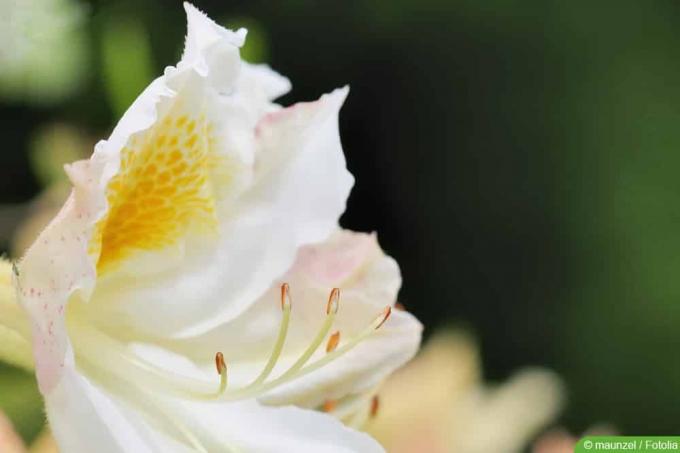
In their homeland, azaleas are outdoor plants. If possible, this existence should also be made possible for them in this country in phases. From the end of May you can move outside. The place must be shaded and sheltered. Staying outdoors promotes the flowering of the azalea and thus ensures the next round of flowers in the coming winter. You can put the pot on the balcony or patio, or plant the azalea in garden soil. As soon as the first night frost is announced, the azalea must return indoors. Even specimens that have been planted out.
substrate
This winter bloomer is a houseplant with special demands on the substrate. You should do this for her own pleasure. It will stay healthy and bloom profusely if rooted like this:
- in an acidic soil
- with a pH of 4 to 4.5
- humus but lime-free
- e.g. B. in rhododendron soil
- alternatively in high-quality potting soil with a proportion of sand
- enriched with acidic coniferous compost
repot
The substrate is useful for the indoor azalea for about two or three years, after which it must be replaced with a new one. With good care, the visible volume of the houseplant also increases over time and needs a larger pot to compensate. Only then can root growth keep up.
- repot every 2-3 years
- best time is after flowering
- before the azalea comes out
- choose a larger planter
- shake old substrate out of the fine roots
- remove dead roots
- Cut back healthy roots
Pour
In caring for this Asian immigrant, both the quality and quantity of water are important to her well-being.
- the warmer the room, the higher the water requirement
- the water supply must be even
- the root ball should always be moist
- but do not stand in waterlogging
- possibly. Put a few pebbles in the bottom of the planter
- the water must not be very calcareous
- otherwise the flowering period will be short or not at all
- chlorosis (yellowing of the leaves) can also occur
- rainwater is ideal
- Soften the tap water beforehand and warm it to room temperature
- there must also be consistently high humidity
- Spray lukewarm daily
- but only the leaves, not the flowers!
Fertilize
Here, too, the azalea turns the usual care of the gardener upside down. Other plants are fertilized during flowering, but the azalea is not.
- fertilize outside of the flowering phase
- from spring to early autumn
- use liquid fertilizer once a month
- preferably the special azalea and rhododendron fertilizer
- take a break from fertilizing from autumn
Cut
Cutting is part of the necessary care for this houseplant. However, this will wait until it has completely faded. Excluded are withered parts of the azalea. You must cut these as soon as possible or remove them by hand so that they do not start to rot in humid air. This cleaning action also ensures a nicer appearance. As soon as the last flower has faded, the shape-retaining pruning awaits. How to cut the room azalea correctly:
- use very sharp scissors
- the shoots must not be crushed under any circumstances
- Scissors must also be clean and disinfected
- Cut houseplants back to 1/3
- above an eye or leaf or Cut side bud
- Cut off dead branches completely
Tip:
Don't skimp on this pruning measure as it encourages an attractive bushy shape.
multiply
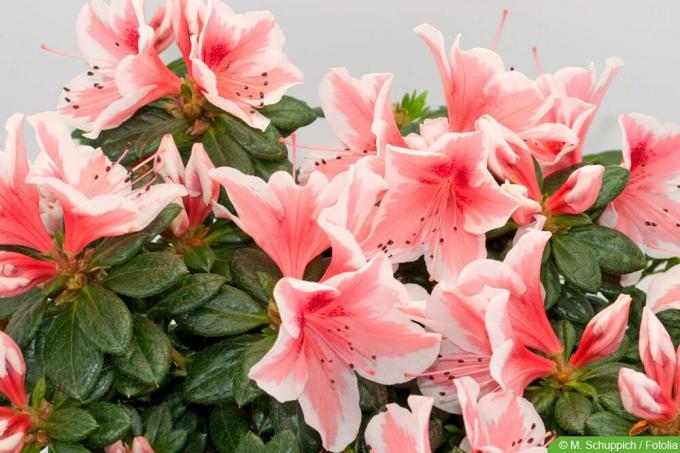
Invest in an azalea once and still transform the whole home into a winter sea of blossoms. This can be achieved through propagation. Only a little patience is required. And of course they have to be content with the fact that every plant blooms in the same way. These are the required steps:
- Take semi-lignified cuttings from the mother plant in early spring. These should each be 8 to 10 cm long.
- Fill small pots with a 2:1 mixture of sand and peat.
- Put one cutting per pot in the ground, 4 to 5 cm deep. Possibly. you must first remove the lower leaves.
- Moisten the soil well. From now on, keep the soil consistently moist but not too wet.
- Put a clear plastic bag over each pot. This increases the humidity.
- Place the pots in partial shade.
- After about 8 to 12 weeks, the cutting will have formed new roots and will begin to grow. Now it's time to transplant it. An acidic substrate suitable for azaleas must be used for this.
diseases and pests
It is usually too dry or too wet substrate that kills this houseplant or at least weakens its health. Pests are happy about the latter, which they can conquer in no time. The following species have been sighted on her:
- Thunderflies and their larvae
- spider mites
- aphids
- white flies
- during outdoor stay: vine weevil
Thunderflies can be controlled with neem oil-based preparations. Collect the vine weevil beetles and fight the larvae with nematodes. Aphids can be easily combated with various home remedies. For example by spraying with a soft soap solution. For this, 20 ml of soap is dissolved in 1 liter of water. The use of predatory mites is helpful against spider mites, which love dry and warm locations. These, in turn, can be ordered easily and inexpensively over the Internet. Yellow leaves can be a reaction to watering that is too chalky. Experts speak of chlorosis.
Tip:
Repot a houseplant that is too wet in new substrate. Cut away any rotting roots.
hibernate
Overwintering an indoor azalea is a challenge. After all, we don't want to deprive ourselves of their beautiful blossoms. Other plants may disappear crowded into a winter quarters. But not the azalea! In its heyday, it needs the stage. Since her admirers live in warm rooms, it is obvious that azalea also spends the winter there. Nevertheless, try to overwinter them as follows so that you can enjoy their flowering for a long time:
- hibernate in the house
- at temperatures between 8 and 16 degrees Celsius
- more heat shortens flowering time
- Make the plant very bright
- but away from heaters, because the air is too dry there
- definitely avoid waterlogging
Tip:
Clever azalea lovers move their azalea every day. In the morning she comes to a place where she can be admired during the day. In the evening it is put back in a cool place. The azalea doesn't seem to mind these frequent moves.
buying tips
Don't let the numerous bright flowers seduce you into buying. These are taking great strides towards withering. It makes much more sense to choose a specimen that will only come into full bloom in your home. Closed buds can and should be in abundance. But take a closer look at these:
- they should be plump and equally developed
- pay attention to dense buds
- even distribution is important
- some open buds are ok
Does the azalea make a good impression overall? Often the pots are unfavorable in the market for days and do not get the necessary care.
Other purchase criteria
- the soil in the pot should be moist
- fallen buds are not a good sign
- the pot should be big enough
- at least half the circumference of the crown
- the leaves should be glossy green and free of dirt
- no traces of vermin may be discernible
Tip:
Even if you have already found the ideal location for the blooming azalea, only move in step by step after purchase. First place it in a cool and shady place for a few days, only then can it get warmer.
flower variations

White and red - these are the two skin colors from which the indoor azalea draws at will. Despite ignoring the rest of the color components, her buds are by no means monotonous. Starting from white to the darkest red, every color nuance is covered. Occasionally fine patterns are added. Single and double flowers, subtle differences in the shape of the flowers and deviations in the flowering period round off the variety of varieties. We have the hard-working breeders to thank for that. They have declared Rhododendron simsii one of their favorites. Take your time with your search so that you can discover your absolute favorites from this wealth of offers. Here are a few suggestions that may charm you:
Alexander
- red
- simple bloom
- Flowering period: January to May
angelina
- pure white
- double flower
- Flowering period: February to May
Antarctica
- light purple
- simple bloom
- Flowering period: February to May
watercolor
- whitepink
- single flower with very attractive markings
- Flowering period: August to May
Christina Matton
- salmon colored
- simple bloom
- Flowering period: December to May
Lady Melanie
- soft pink
- white border of flowers
- dark speckles
- Flowering time: March to May
De Waele's favourite
- pink
- simple bloom
- white border of flowers
- Flowering time: March to May
Friedhelm Scherrer Roze
- pink
- simple bloom
- Color varies from light to dark
- Flowering period: January to May
Ilona
- pink
- simple bloom
- wide border of flowers in white
- Flowering period: August to May
Inga
- pink
- simple bloom
- white border of flowers
- Flowering period: August to May
Queen Fabiola
- white and orange-red
- simple and very beautiful flower
- Flowering period: February to May
Madame De Croock
- white bloom
- easily filled
- with red speckles in the middle
- Flowering time: November to February
Sachsenstern
- white
- simple bloom
- delicate red flower border
- Flowering period: February to May
TerraNova
- pink
- funnel shaped
- double flower
- Flowering period: August to April
Venus
- pink
- white border of flowers
 garden editorial
garden editorial I write about everything that interests me in my garden.
Learn more about houseplants
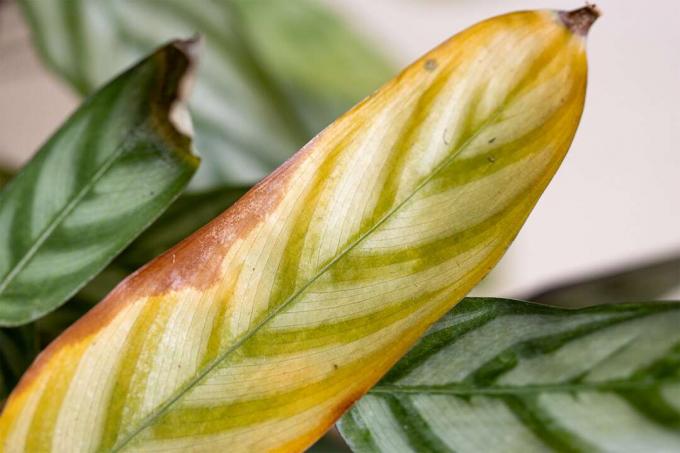
Calathea has yellow leaves: how to save?
When a Coriander (Calathea) gets yellow leaves, the cause is usually a lack of care. In order to save them from dying, a number of countermeasures must be taken, which are described in detail here.

Room bamboo: 13 tips for care
The room bamboo impresses with its compact growth habit and is a densely grown houseplant. The ten most important tips for caring for the sweet grass are compiled for you here.
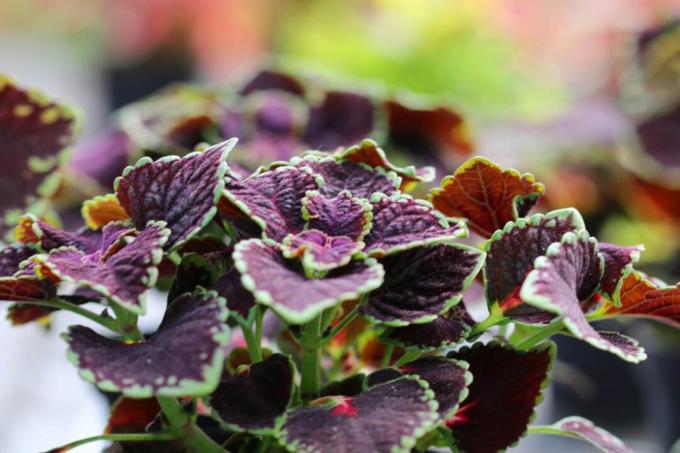
Coleus blumei: 21 tips for the red nettle
The colored nettle is a warmth-loving and easy-care foliage plant. The coloring of the leaves varies from monochromatic to variegated with a wide variety of drawings. Spectacular splashes of color can be set in beds, balcony boxes and tubs or as a houseplant.
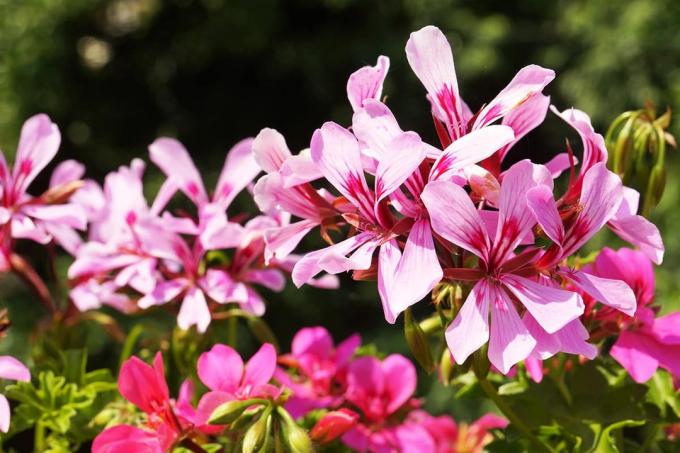
Scented houseplants: 25 scented plants for the home
An apartment without indoor plants is hardly conceivable. Scented plants in particular have a very special effect. Not only are they decorative, they can lighten the mood and rival any artificial home fragrance.

Lucky chestnut, Pachira aquatica: care from A to Z
The care of the lucky chestnut does not require any special expertise. However, if you know the way of life of this ornamental plant, you can better adapt site conditions and care measures to your needs. The plant can be easily propagated if a plant already exists.

Rubber tree: 13 care tips for Ficus elastica
The rubber tree is one of the most popular indoor plants. It is available in different varieties, easy to care for and stands out for its large leaves, which are colored in intense shades of green. Within a few years, it grows into a state small tree without much effort.
